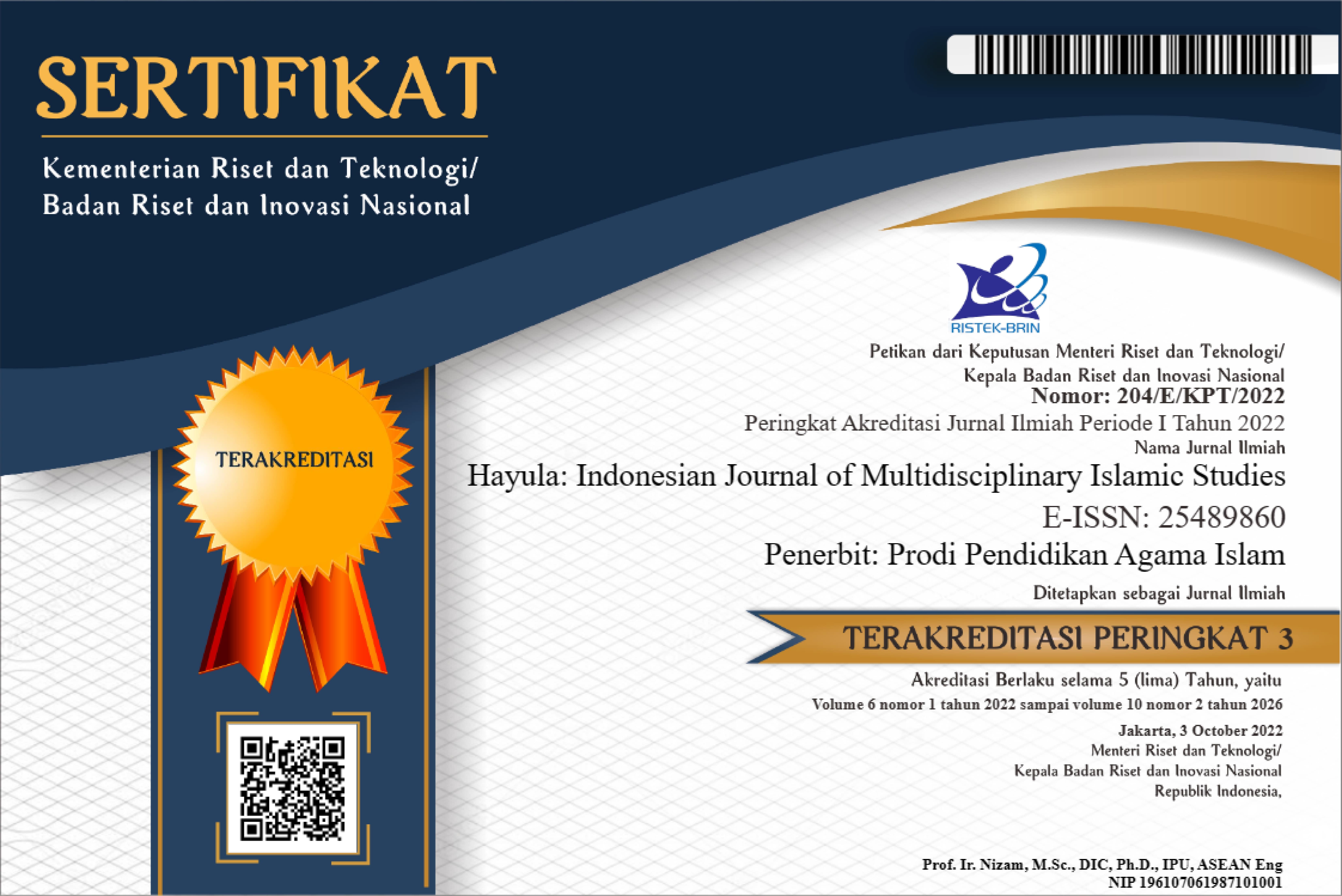Nilai-Nilai Spritualitas dan Harmoni Beragama dalam Wirid Harian Kitab Al-Aurad Al-Nur'aniyyah
DOI:
https://doi.org/10.21009/hayula.002.2.03Keywords:
Wirid, Tariqat, Religious spiritualityAbstract
This research is based on religious issues that are stuck to the practice of normative zhahiriyah. Whereas the religious perfection lies precisely in the balance in practicing the religious zhahiriyah and bathiniyyah. In the religious teachings that bathiniyyah can actually grow and develop religious spirituality. Wirid Al-Aurad Al-Nur'aniyyah taught by tariqat al-Syadziliyyah containing readings is assumed to foster spiriualitas, harmony of religious behavior, not monolithic and tolerant. For this reason this study aims to describe and analyze the religious arguments about wirid. Then describe and analyze the texts, meanings, and interpretations of wirid Al-Aurad Al-Nur'aniyyah. Finally, analyze the relevance of such wirid practice in developing religious spirituality. This research uses qualitative research approach with descriptive research method and literature study. Descriptive method and literature study is used to describe the study of tasawuf and wirid in religious perspective. Then describes the data concerning wirid Al-Aurad Al-Nur'aniyyah, translating, and interpreting the meaning of wirid readings, and analyzing their relevance to the development of religious spirituality. The results showed that the daily wird of Al-Aurad Al-Nur'aniyyah readings such as al-Fatihah, al-Waqi'ah, shalawat, tahlil, tahmid, etc. as tariqat al-Syadziliyyah founder contained the meaning meaningful and relevant in developing religious spirituality. Wirid also as one effort in shaping the character of Islamic spirituality (Sufism). The wird that includes some form of remembrance and prayer contains an invitation to create harmony of life, pray for salvation and prosperity for all humanity regardless of religion and religious school.
References
‘Allaa>mah Ja>r al-La>h ˋAbi> Qa>sim Ma, a. Z. (1998). Al-Kashsha>f ‘an Ḥaqa>ˋiq Ghawa>mid} al-Tanzîl wa ‘Uyu>n al-ˋAqa>wîl fî Wuju>h al-Taˋwi>l. Riyad}: Maktabah al-‘Abîka>n.
Abu al-Fad}l Shiha>b al-Di>n, a.-‘. A. (xxvii). Ru>ḥ al-Ma’a>ni> fi> Tafsi>r al-Qur`a>n al-‘Azhi>m wa al-Sab’ al-Masa>ni>. Beirut: Da>r Iḥya>` wa al-Tura>s al-‘Arabi>.
Al-Aurad Al-Nura>niyyah. (t.thn.).
Al-Qur’an al-Azhim. (t.thn.).
(1995). The Encyclopedia of Religion. In M. Eliade. New York: Simon dan Schuster.
Fakhr al-Di>n bin ‘Alla>mah D}iya>, M. R. (1981). Tafsi>r al-Fakhr al-Ra>zi>. Beirut: Da>r al-Fikr.
Gharib, M., & al-Sha>zili>, A. a.-Ḥ. (2000). Ḥaya>tuhu, Tas}awwufuhu, Tala>mi>zuhu> wa Aura>duh. Kairo: Da>r Gharîb.
Ghaza>li>, A. (t.thn.). Iḥya>` Ulu>m al-Di>n. Semarang: Karya Toha Putra.
Ibnu ‘As}u>r, S. M. (1984). Tafsi>r al-Taḥri>r wa al-Tanwi>r. Tunis: al-Da>r al-Tu>ni>siyyah.
Jaeliy al-, A.-S.-K. (1375 H). Insan al-KÄmil fi Ma’rifat AwÄliri wa al-AwÄ’il (Jilid II ed.). Mesir: Syarikah Matba’ah Mustafa- Babil Halabi wa AlÄdih.
Kasi>r, I., & Isma>'îl bin ‘Umar al-Dim, A. a.-F. (2000). Tafsi>r al-Qur`a>n al-‘Az}i>m. Beirut: Da>r Ibnu Hazm.
Madjid, N. (1995). Islam Agama Peradaban, Membangun Makna dan Relevansi Doktrin Islam Dalam Sejarah. Jakarta: Yayasan Paramadina.
Nurwardani , P. (2016). Pendidikan Agama Islam Untuk Perguruan Tinggi. Jakarta: Direktorat Jenderal Pembelajaran dan Kemahasiswaan Kemenristekdikti.
Ruslan, H. (2008). Menyingkap Rahasia Spiritualitas Ibnu ‘Arabi (Cet. I. ed.). Makassar: Al-Zikra.
Suyu>thi> al-, J. a.-D. (2003). Al-Durr al-Mansu>r fî al-Tafsi>r bi al-Ma`su>r. Kairo: Markaz Hijr li al-Buḥu>s wa al-Dira>sa>t wa al-Isla>m.
Zamkhsyarî al-, ‘.-L. (1998). Al-Kasysyâf ‘an Ḥaqâˋiq Ghawâmidh al-Tanzîl wa ‘Uyûn al-ˋAqâwîl fî Wujûh al-Taˋwîl. Riyadh: Maktabah al-‘Abîkân.
Zuhaili> al-, W. (2009). al-Tafsi>r al-Muni>r fî al-‘Aqi>dah wa al-Shari>’ah wa al-Manhaj (Cet. X ed.). Damaskus: Da>r al-Fikr.
Downloads
Published
How to Cite
Issue
Section
License
Authors who publish with this Journal agree to the following terms:
- Author retain copyright and grant the journal right of first publication with the work simultaneously licensed under a creative commons attribution licensethat allow others to share the work within an acknowledgement of the work’s authorship and initial publication of this journal.
- Authors are able to enter into separate, additional contractual arrangementfor the non-exclusive distribution of the journal’s published version of the work (e.g. acknowledgement of its initial publication in this journal).
- Authors are permitted and encouraged to post their work online(e.g. in institutional repositories or on their websites) prior to and during the submission process, as it can lead to productive exchanges, as well as earlier and greater citation of published works.
Users/public use of this website will be licensed to CC BY






